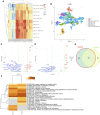LFSC: A linear fast semi-supervised clustering algorithm that integrates reference-bulk and single-cell transcriptomes
- PMID: 36531230
- PMCID: PMC9754124
- DOI: 10.3389/fgene.2022.1068075
LFSC: A linear fast semi-supervised clustering algorithm that integrates reference-bulk and single-cell transcriptomes
Abstract
The identification of cell types in complex tissues is an important step in research into cellular heterogeneity in disease. We present a linear fast semi-supervised clustering (LFSC) algorithm that utilizes reference samples generated from bulk RNA sequencing data to identify cell types from single-cell transcriptomes. An anchor graph is constructed to depict the relationship between reference samples and cells. By applying a connectivity constraint to the learned graph, LFSC enables the preservation of the underlying cluster structure. Moreover, the overall complexity of LFSC is linear to the size of the data, which greatly improves effectiveness and efficiency. By applying LFSC to real single-cell RNA sequencing datasets, we discovered that it has superior performance over existing baseline methods in clustering accuracy and robustness. An application using infiltrating T cells in liver cancer demonstrates that LFSC can successfully find new cell types, discover differently expressed genes, and explore new cancer-associated biomarkers.
Keywords: anchor graph; bulk RNA-seq; clustering; data integration; single-cell RNA-seq.
Copyright © 2022 Liu, Liang, Wang and Li.
Conflict of interest statement
The authors declare that the research was conducted in the absence of any commercial or financial relationships that could be construed as a potential conflict of interest.
Figures








References
-
- Chung F. R. K., Graham F. C. (1997). Spectral graph theory. Rhode Island, United States: American Mathematical Soc.
LinkOut - more resources
Full Text Sources

